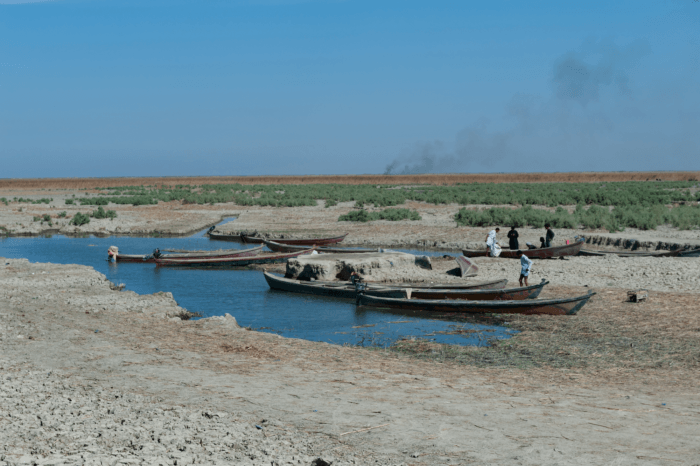On 30 November 2021, WRMC Special Advisor Allan Rock spoke at the David Petrasek Memorial Forum hosted by the University of Ottawa, Climate Change, Migration, Human Rights & Conflict: Vital Interdependence. He discussed the changing nature of contemporary migration and refugee flows resulting from the lethal combination of climate change and violent conflict. Below is a summary of his remarks. You can watch the video recording of the event aquí.
More than 30 years ago, the UN’s Intergovernmental Panel on Climate Change observed that the single greatest effect of climate change could well be forced human migrations. More recently, in 2019, the High Commissioner for Human Rights asserted that climate change poses the greatest threats to human rights in the 21st century along with its relation to conflict.
It is too simplistic to state that climate change, but it lays bare, and it makes it worse. Tensions and conflicts that can be amplified by climate change, such as competition over scarce resources, ethnic rivalries or competing claims for land, can interact with other factors and ultimately lead to conflict. For example, a recent study in Africa found that an increase in temperature of one degree centigrade led to a 54% increase in the probability of conflict in places where there are both farmers and herders because of desertification and a shortage of arable land.
Countries experiencing conflict are less able to cope with climate change, precisely because their ability to adapt is weakened by that very conflict, and often state failure as well. According to the International Committee of the Red Cross of the 25 countries deemed most vulnerable to climate change, 14 are mired in conflict at present. If not direct causation between conflict and climate change, there is at least strong correlation.
In 2019, 2000 disasters internally displaced almost 25 million people across 140 countries and territories. Almost all those disasters were weather related hazards – extreme events like floods and storms. Regarding cross-border displacement, the UNHCR reports that the number or people fleeing the country because of climate change continues to grow year-by-year, and account for an increasing proportion of transnational migrants.
The UNHCR insists – and rightly so – that these migrants cannot be called refugees or climate refugees because they don’t fall within the parameters of the 1951 convention definition on refugees. So what do we call them? And how do we deal with transnational migrants escaping the consequences of climate change in their own countries?
The Nansen Initiative – named after the Norwegian diplomat who was the commissioner for Refugees and the League of Nations and won a Nobel Prize for devising a certificate that allowed refugees after the First World War, to travel and resettle – identified at least 50 countries that had in recent decades, received and not returned people who had fled across borders, because of climate disasters, the greatest number of them in Africa, and Central and South America.
In analyzing those cases, the Nansen Initiative found only ad hoc policies improvised and made up on the fly to deal with the consequences of these climate change disasters were responsible for assisting those displaced by climate change. There is a complete lack of preparedness internationally to respond to this increasing phenomenon.
Given that cross-border migrants move because of climate are only going to become more common, the Initiative made concrete recommendations to all UN member states, based on the need to prepare for increased migrant flows in the future so that we collectively build resilience to prevent displacement. In doing so there must be better infrastructure, wiser urban planning, and sensible land reforms while governments anticipate climate change, its consequences, and engage in planned relocation when appropriate. Further, when populations are internally displaced, states respond more with compassion and meet their needs, so they’re less likely to free to flee across a border
109 UN member states have endorsed the recommendations of the Nansen Initiative, but its global implementation is far from assured. Many low-income countries lack the resources necessary to put mitigation and resilience measures in place. Yet, it’s not just lower income countries. Look at what happened in British Columbia in the late fall of 2021 in Canada. We see that even developed countries are sometimes caught flat footed when extreme weather events occur, without measures to mitigate the impacts of climate change.
So, if climate change and conflict are correlated, displacement in common to both, and both exist in greater numbers when they coexist, while weather related disasters along are producing more of the displaced both internally and across borders, how should the international community respond – especially at a time when there are more conventions on refugees than ever before?
For those of us who seek to emulate David Petrasek’s example, the response to force displacement, including that caused by climate change, must be based on human rights. Human rights standards and principles can inform and strengthen policy responses to climate change by promoting coherent legitimacy and sustainable outcomes. A rights-based approach assists policy making by revealing legal duties and creates a framework to reveal legal obligations so steps can be taken to enforce them.
I conclude by observing that adopting a bold approach firmly rooted in human rights, is what David Petrasek would have advocated to address the challenge of climate-related displacement, and perhaps the best way to honour his memory is to do just that.
Image: John Wreford / Shutterstock.com

